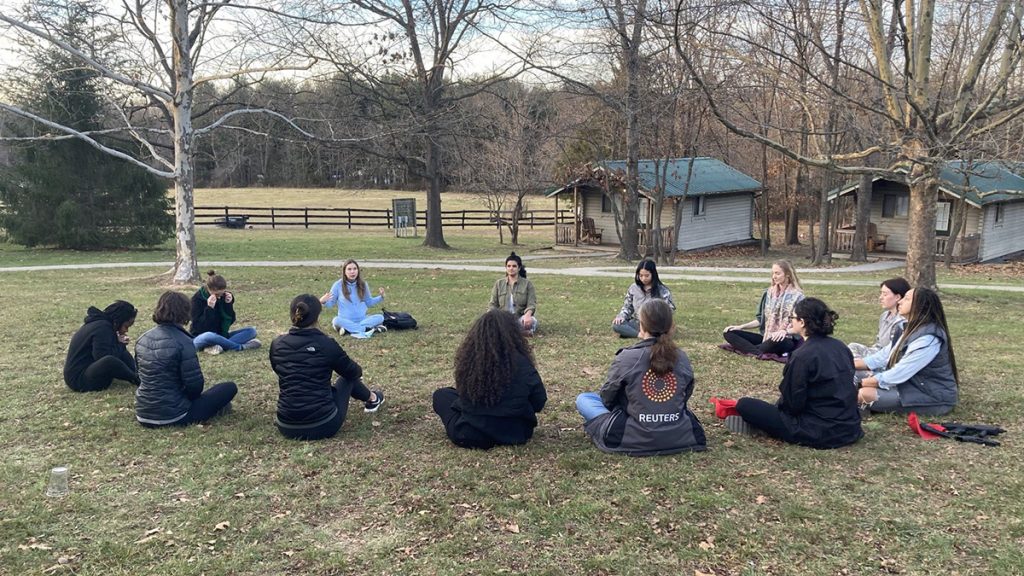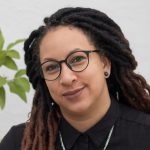
The International Women’s Media Foundation NextGen Fellows cohort perform grounding exercises after completing a first aid scenario at the December 2021 Virginia fellows retreat and training. Photo: Tara Pixley
Building a resource-sharing community
Why collaboration and accessibility are at the core of the Journalism Source of Safety project
On a wintery Virginia day in 2021, in a room full of women and nonbinary journalists, a safety trainer posed the question: “What do you already do to keep yourself safe?” I listened as one person after another offered their lived experiences as comedic anecdotes, cautionary tales, and hard-won advice — first tentatively and then more assertively amid chuckles and head nods. We were all able to feel that we not only had important knowledge to offer, we also all had something to learn from each other.
As women or femme-presenting journalists working in a profession and a society that rarely validates our lived experience, the daily work of reporting can be isolating and undermining. However, the space of that weeklong safety training facilitated collaborative learning that valued our disparate and diverse self-acquired safety practices.
Speaking to me later, IWMF’s Senior Program Coordinator Maria Alejandra Silva Ortega (who was also in that room at the time) highlighted the value of creating that kind of space, saying it is this “community aspect, being in a room with all women and feeling comfortable to share their experiences” that makes the International Women’s Media Foundation journalist safety training unique from other hostile environment and first-aid training.
It was certainly impactful for me, as it inspired the work I’m doing now as an RJI Fellow. That conference room in rural Virginia is where I first conceived of the Journalism Source of Safety project, imagining part of it as a global network of individuals with information and experiences to share that might make the work of journalism less risky for everyone.
Recent movements in journalism are shifting toward thinking of the communities we cover as collaborators and understanding that “community-engaged” reporting means including those collaborators from story conception to publication. Those same words of “community” and “collaboration” came up over and over again in the last six months as I interviewed dozens of journalists about their experiences with safety training and perspectives on risk management in journalism.
The observations ranged from USC Investigative Journalism Fellow Jen Byers’ assertion that authentic engagement with communities can save your life in civil unrest situations to independent photojournalist Rosem Morton’s acknowledgement that collaboration is an integral part of effective safety training because no one person is a true expert at all of these things.
The observations ranged from USC Investigative Journalism Fellow Jen Byers’ assertion that authentic engagement with communities can save your life in civil unrest situations to independent photojournalist Rosem Morton’s acknowledgement that collaboration is an integral part of effective safety training because no one person is a true expert at all of these things. Morton, who is also the resident first aid and trauma expert for J-SOS, told me collaboration is important because it recognizes that “all participants (of a safety training) have knowledge they can contribute to the group and it allows multiple trainers to share their expertise” in a way that builds a holistic knowledge base.
J-SOS has adhered to those ideas as its guiding light, while also specifically centering the knowledge and expertise of women, nonbinary, Black, brown and immigrant journalists from its inception. All seven of the project’s collaborators are women and nonbinary people of color bringing a range of global perspectives — Haitian, Egyptian, Filipina, Jamaican, Dominican, Puerto Rican — to the creation of a different kind of journalist safety resource. The materials we have collaboratively crafted over the last six months seeks to flip the imagined white, Western, male journalist of typical journalist safety training that so often leaves out necessary considerations for everyone else. Focusing on the needs of people whose intersecting identities require more expansive safety resources was another core rationale for creating J-SOS.
Not only are different embodiments and experiences often marginalized in safety training, safety resources that allow for collaborative knowledge sharing and community-building around safety advice are practically non-existent. After many hours spent combing through the myriad available safety resources online, it appeared that very few (if any) discussion spaces were openly accessible to a broad public of journalists. One WhatsApp channel I found was created to host conversations among journalists about safety advice and resources, but it required an approval process to access the group chat and no previous conversations were viewable to those new to the chat.
Journalists need a living resource of collective knowledge that is easily accessible, engaging, and understands that the global network of journalists is as diverse and wide-ranging in its information needs as the world’s population itself.
So, I have returned again to what originally brought me to the J-SOS project: crafting a space of shared ideas within a community, a desire for transparency, and prioritizing collaboration. With that in mind, I hope to hear from you.
- What kind of community do you want to see built to trade advice, experiences and resources around journalism safety?
- What formats and shared spaces do you think would best provide that? Online? In person? Social platforms?
- How can we create that space together?
I would love to hear from you! Connect with me via email: info@sourceofsafety.org
Resources
Take the Safety Survey: Part of this project is trying to assess the safety and risk management needs of visual journalists around the world. Please take this survey to offer your thoughts, experiences and what you want to see taught in journalism safety training!
Follow us on Twitter and share your safety tips, gear and anecdotes from on the ground experiences using #sourceofsafety.
I have put together a list of readings and an accessible Google Drive of resources that will be continuously updated over the course of this project and beyond. Please email info@sourceofsafety.org if you have any suggestions for guides, checklists, reports, templates or anything else to add to these living resources.

Comments